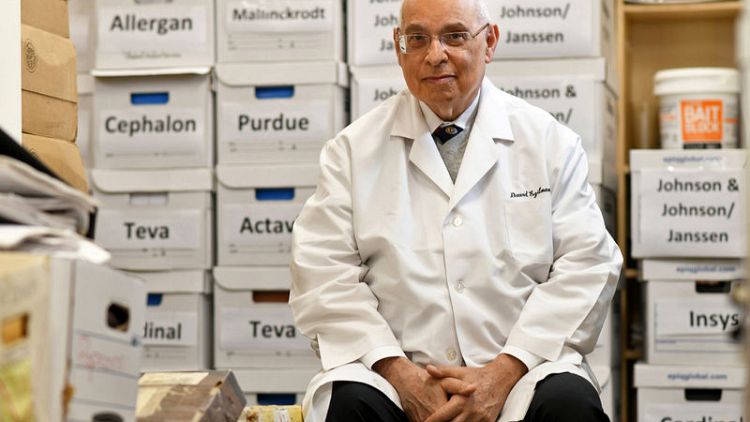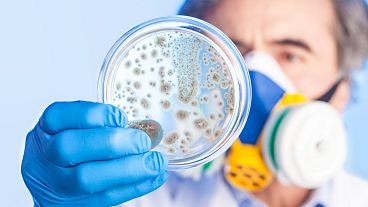By Lisa Girion and Chad Terhune
(Reuters) - At an invitation-only gathering late last year, U.S. regulators and their guests huddled at a hotel near Washington, D.C., to discuss the best way to detect cancer-causing asbestos in talc powders and cosmetics.
The “Asbestos in Talc Symposium,” sponsored by the Food and Drug Administration, was dominated by industry hands: Most of the 21 non-government participants had done work for talc companies, such as testing and serving as expert witnesses and consultants, symposium documents and other records show.
Key sessions were led by witnesses for Johnson & Johnson in lawsuits alleging the company failed to warn customers that its Baby Powder was tainted with cancer-causing asbestos, the records show. Others who sought invitations were turned away, including a physician who had testified against J&J in trials that resulted in billions of dollars in damage awards against the company.
History was repeating itself.
Over the past 50 years, the FDA has relied upon - and often deferred to - industry even as outside experts and consumers repeatedly raised serious health concerns about talc powders and cosmetics, a Reuters investigation found.
Again and again since at least the 1970s, the agency has downplayed the risk of asbestos contamination and declined to issue warnings or impose safety standards, according to documents produced in court proceedings and in response to public records requests.
The agency said it lacks the authority to require manufacturers to test for asbestos in talc or report any results. And it seldom has ordered its own tests - until recently.
Amid heightened scrutiny in Congress, a criminal investigation of J&J and costly jury verdicts against the company, the regulator commissioned tests that found asbestos in 11 talc-based cosmetics, including Johnson’s Baby Powder. J&J recalled 33,000 bottles.
Raja Krishnamoorthi, an Illinois congressman who chairs a U.S. House subcommittee investigating talc safety, told Reuters it was time for regulators to stop relying on manufacturers’ safety assurances.
“When something as serious as cancer or carcinogens are at issue,” Krishnamoorthi said, “self-regulation doesn’t make a lot of sense.”
In written responses to questions from Reuters, the FDA said its resources and authority to regulate the cosmetic industry are limited. The agency said it has no power to ensure the safety of cosmetics before they are put on store shelves, nor to force companies to pull them off when potential hazards are discovered.
“We are dependent on manufacturers to take steps to ensure the safety of their products,” the FDA said after announcing a voluntary recall of tainted cosmetics in March.
FDA officials declined to comment on the decisions of former employees over the years, saying only that the agency relies on the best information available and that studies “have improved our understanding of how and why asbestos fibres are hazardous.”
The agency said it now recognises, as the World Health Organization and other public health agencies did years ago, that there is no known safe level of asbestos. FDA officials said their current policy is to act swiftly - and if necessary encourage recalls - even when small amounts are discovered.
The regulator has stood by its recent tests of Johnson’s Baby Powder, despite pushback from the company.
J&J, the world’s largest producer of talc powders, said in a statement that it recalled the 33,000 bottles of Baby Powder out of an “abundance of caution.” Eleven days later, the company announced that tests by labs it hired had determined that there was no asbestos - other than some contamination it said came from an air conditioner - in samples from the one bottle tested by the FDA and the batch it came from.
In written responses to Reuters, J&J said it systematically tests its talc and has always found its powders to be safe and pure. “Throughout the 1970s and '80s, the FDA and other regulatory bodies defended talc,” J&J's Chief Executive Alex Gorsky testified in an Oct. 3 deposition. “FDA agreed overall with the position that we had taken with the safety of our talc.”
The company told Reuters that it “has long cooperated (with) and supported the FDA in its mission to protect the public health,” and that any suggestion it has unduly influenced the agency to reduce regulation or standards is “just false.”
The FDA now is under increasing pressure to ensure talc powders and cosmetics are free from asbestos. The agency’s testing of talc-based cosmetics this year followed jury verdicts totalling more than $5 billion against J&J in cancer lawsuits, as well as a Dec. 14 Reuters report showing that J&J knew its raw talc and powders sometimes tested positive for asbestos from the 1970s into the early 2000s and did not report those findings to the agency.
J&J has disputed the Reuters report as "one-sided, false and inflammatory."
In the wake of the Reuters report, the company announced it was under investigation by the U.S. Department of Justice and the Securities and Exchange Commission. According to people familiar with the matter, these include a criminal grand jury probe into how forthright J&J has been about the safety of its powders.
'NO HEALTH HAZARD'
The FDA began looking into talc safety in 1971 after researchers at Mount Sinai Medical Center in New York found what appeared to be asbestos in unnamed brands of talc powder.
Two years later, FDA records show, the agency found asbestos in a sample of Shower to Shower, a J&J powder at the time that was made with the same talc as Johnson’s Baby Powder. The FDA never publicly announced the finding.
J&J told Reuters the result was not final, citing findings in an FDA table issued in 1976. But that table, reviewed by Reuters, is ambiguous, listing no result for the type of asbestos found in 1973.
J&J told Reuters the gap means no asbestos was found.
Assured by J&J and other manufacturers that their talc was safe, the FDA eventually ended its inquiry without taking action because “the potential hazard did not warrant a recall,” Heinz J. Eiermann, a former J&J researcher who at the time ran the agency’s cosmetics division, wrote in a March 1976 memo.
That same year, J&J, other talc companies and their trade group, the Cosmetic Toiletry and Fragrance Association, persuaded FDA officials that manufacturers could monitor the safety of their own products, according to records J&J and the group produced in litigation.
The FDA dropped plans to impose testing and purity standards for talc powders and cosmetics. The trade group published its own test, which was voluntary for companies to use. The written standard for that test acknowledges that it cannot detect most types of asbestos at low levels, nor one common type - chrysotile - at all.
In a statement to Reuters, the trade group said it believed that chrysotile was not commonly linked to talc used in cosmetics.
Chrysotile is the type of asbestos the FDA-commissioned test found in Baby Powder this year. It also was found in several tests conducted by labs for J&J on its talc from 1972 through 2003, according to records produced in litigation. J&J has said that some of the tests were on industrial talc and that others, on Baby Powder talc, reflected background contamination.
Asbestos is a loose term for a group of six minerals that readily separate into needles or fibres. Easily inhaled, they are known to cause lung, ovarian and other types of cancer. While most people exposed never get cancer, for some even small amounts are enough to trigger the disease. Just how small has not been established.
'A BIG ISSUE'
Talc safety concerns resurfaced in 1983 when a graduate student scouring geology journals for a toxicology class came across information he considered disturbing: Talc deposits are commonly laced with asbestos, a similar mineral.
Philippe Douillet immediately thought of the talc powder his sister used on her baby, he recalled in an interview with Reuters. He urged her to stop using it. Then he petitioned the FDA to require an asbestos warning on talc powders.
“It was really obvious to me there was a big issue there,” said Douillet, who now runs a biotechnology company in Miami.
When the FDA began evaluating Douillet’s petition, it looked to J&J for key information, agency records show. The FDA’s June 1985 risk assessment relied upon a decade-old letter from the company for the agency’s estimate of the amount of dust babies were exposed to during diapering.
That 1974 letter from J&J to the FDA said that, hypothetically, even if babies were exposed to talc powder with as much as 1% asbestos, it would be a far lower concentration than allowed at the time for industrial workers.
J&J told Reuters in a statement that “at no point has Johnson & Johnson taken the position that it would consider talc containing 1% asbestos appropriate for sale to consumers.”
In the end, the FDA decided there was no need for an asbestos warning on talc powders. In a July 1986 letter to Douillet, acting associate FDA commissioner J.W. Swanson wrote that the quality of cosmetic talc had improved “and that even when asbestos was present, the levels were so low that no health hazard existed.”
What’s more, Swanson wrote, agency officials had come to question earlier reported findings of asbestos in talc powders. Those doubts, he wrote, were based in part on a paper published in the proceedings of a 1977 scientific conference.
Both of the paper’s authors had worked for J&J, one as an asbestos testing contractor and the other as its longtime talc supply manager. The authors argued that some testing methods were apt to misidentify microscopic lookalike rock splinters as asbestos. The industry’s test, the paper said, was designed to avoid this confusion.
Other U.S. and European public health authorities have come to regard such splinters as presumptive toxins because of their similarity to asbestos.
The FDA defended its 1986 decision to reject Douillet’s petition. In a statement, it said the graduate student “did not provide persuasive evidence that the cosmetic talc produced at the time contained significant amounts of asbestos minerals.”
NOT A PRIORITY
Eight years later, the regulator received a new request for a warning label on talc powders. This one came from Dr. Samuel Epstein, a University of Illinois environmental medicine professor who chaired the Cancer Prevention Coalition, an advocacy group.
Epstein’s 1994 petition didn’t concern asbestos. It raised the possibility that talc, by itself, was a hazard worthy of a warning label. His petition was based on research showing that talc, when used as an antiperspirant and deodorant in underwear, was associated with ovarian cancer.
In a brief July 1995 letter, FDA acting cosmetics chief John Bailey told Epstein's coalition that the agency had taken no action because it had other priorities.
Bailey told Reuters in a statement that he issued this “interim” response because the petition lacked scientific support.
In 2002, having taken no action on the petition, Bailey moved to the cosmetic trade group, now known as Personal Care Products Council. The council considered him a “key employee” because of his “former employment with the FDA,” according to a tax filing by the group.
Now a consultant, Bailey serves as a litigation expert witness to J&J and other talc companies. In his statement to Reuters, Bailey said he had been hired at the council “as a scientist responsible for applying sound science to decision making.” He disputed Reuters’ finding that the FDA deferred to industry, saying the agency takes potential health concerns seriously and does its own evaluations.
In 2006, the World Health Organization’s International Agency for Research on Cancer classified use of talc powder in the perineum area - the pelvic region between the legs - as “possibly carcinogenic.” Two years later, Illinois medical scientist Epstein filed a second petition to the FDA seeking a cancer warning label on talc products.
J&J went to work to defeat it. In a May 2008 email to colleagues, J&J executive Kathleen K. Wille wrote: “Our response could be a potential source of data and information on which the FDA can base their response.”
Together, J&J, its talc supplier and the Personal Care Products Council arranged for a pair of scientists to assess the published studies that linked talc and ovarian cancer, according to emails and other records produced in litigation. The scientists concluded that the evidence was too weak to consider talc as a cause.
At a May 2009 meeting, Bailey, Wille and other industry representatives briefed FDA officials on the assessment, according to a meeting memo produced in litigation by J&J’s talc supplier.
Three days later, Wille told colleagues in an email, “We have every confidence that the FDA will dismiss this petition once they have reviewed our submission.”
J&J told Reuters in a statement that the company had been confident because it believed the agency would be swayed by science, which it said supported J&J’s position that talc does not cause ovarian cancer.
Before the FDA ruled on the warning requests, however, concerns about asbestos contamination flared again. This time, the FDA’s South Korean counterpart reported finding asbestos in talc powders.
Acting on that 2009 report, the FDA commissioned talc tests for the first time in 40 years, hiring Maryland-based AMA Analytical Services Inc, which analysed 34 samples of talc powders and cosmetics, including Johnson’s Baby Powder. It found no asbestos in any of them.
The lab had no experience testing for asbestos in talc. Its prior work focused on building materials such as vinyl flooring, according to the deposition testimony of AMA lab director Andreas Saldivar.
The FDA has said Saldivar’s lab used “the most sensitive techniques available” but cautioned that the results were limited to the 34 talc powders and cosmetics tested.
The testing had other limitations as well. Saldivar’s lab looked at less talc per sample than other labs that have found asbestos in talc powders. And it did its work in a fraction of the time typical for such analyses, according to a Reuters review of the lab report and interviews with experts who test talc for asbestos.
Saldivar’s lab was recently rehired by the FDA. This time, it found the asbestos that led to the first recall of J&J’s iconic Baby Powder. Saldivar declined to comment.
DUTY TO WARN
In the first verdict of its kind, a South Dakota jury found in October 2013 that J&J had a duty to warn women that research had linked its talc powder to ovarian cancer. No damages were awarded.
Then the FDA weighed in on the issue. In April 2014, 20 years after Epstein first contacted the agency, the FDA rejected both of his petitions for warning labels. Its announcement said the science wasn’t strong enough to support a cancer warning, echoing the assessment J&J and its industry partners had presented to the agency in 2009.
In court, such arguments have not always proved convincing. In early 2016, a Missouri jury concluded J&J’s powders caused a woman’s ovarian cancer death and awarded her survivors $72 million. An appellate court later set that verdict aside, ruling that the woman had filed her suit in the wrong state.
In the aftermath, the FDA asked J&J for “safety literature and data regarding talc,” correspondence shows. The company submitted a report saying no asbestos had “ever been found during any testing” of its talc.
Since then, lawsuits have compelled J&J to produce internal documents that show the company knew its talc and powders had tested positive for asbestos on occasion for decades.
The company now faces more than 16,000 lawsuits alleging that its powders caused ovarian cancer and mesothelioma, an incurable cancer. The vast majority are awaiting trial. In court, there have been mixed verdicts, mistrials and some appellate rulings in J&J’s favour.
Last year, in response to renewed asbestos concerns, FDA cosmetics chief Linda Katz began organising the November 2018 symposium and a public hearing on talc testing, now planned for next year.
She reached out to J&J for help. J&J vice president Jethro Ekuta responded by sending Katz a letter in June 2018 recommending a list of three talc testing experts. All three had served as defence witnesses or consultants for J&J.
Two of the experts Ekuta recommended, as well as a third J&J defence witness, led sessions at the closed-door “Asbestos in Talc Symposium” on Nov. 28, 2018. None of the sessions were led by medical experts who had questioned the safety of talc powders and cosmetics.
J&J said that apart from recommending experts, it did not advise the FDA on the symposium. Ekuta, who has left J&J, declined to comment.
NOT INVITED
In a statement to Reuters, the FDA downplayed its role in the symposium, saying the event was “hosted” by the Joint Institute for Food Safety and Applied Nutrition (JIFSAN), a research group co-founded by the FDA. “No formal or regulatory recommendations were expected or made,” the agency said.
In fact, records show, the FDA initiated and paid for the meeting, set the agenda and chose the participants.
The meeting set the stage for formal recommendations on how to test products used every day by millions of people. The FDA said a government committee tasked with proposing a standard test for asbestos in talc powders and cosmetics is “continuing to work through issues discussed at the JIFSAN symposium.”
Many FDA meetings are held in public and invite comment. Details on the talc symposium were hard to come by, however, even after it was over.
The FDA declined Reuters’ requests to provide a list of participants or any information on what transpired. After Reuters filed a public records request with JIFSAN, the research group posted meeting information online and released planning emails.
The guest list showed that more than half of the 54 participants were employed by or recently retired from FDA and other agencies. Of the 21 non-government participants, 17 had either worked for talc companies, done lab testing or served as expert witnesses for the industry, Reuters found. Five of the participants affiliated with talc companies also have served as expert witnesses for plaintiffs. Most of the non-government participants were experts in geology or minerals testing.
In a statement, the FDA said it would ordinarily avoid having sessions led by defence or plaintiff witnesses. However, the agency said there are a “limited number of experts worldwide with scientific knowledge” on asbestos testing, standards and results analysis.
Not everyone was welcome.
Among those turned away was Dr. David Egilman, a clinical professor of family medicine at Brown University. He testified last year in a trial that ended in a $4.69 billion verdict for women alleging J&J’s talc powders caused their ovarian cancers.
Egilman told Reuters he was concerned that if the FDA was guided by geologists and industry consultants, it might overlook fundamental questions about which mineral fibres cause cancer. He wanted to offer his expertise, as a physician and researcher, on what technicians should look for under the microscope.
Testing hinges “on the determination of what particles or elements should be tested for,” he wrote in a November 2018 email to organizers asking to be included in the symposium. “This is a medical question and not a technical question.”
Katz took a different view. In an email forwarded to Egilman, she said: “This meeting is not intended to discuss health-related issues or concerns.” She met with Egilman later.
Katz also told Egilman that the symposium was not intended to reach any consensus. At its conclusion, however, session leaders, including three who have served as defence witnesses for J&J, drafted what they called “consensus” or “concurrence” reports.
Two of the reports reviewed by Reuters embraced industry positions on what fibres should be counted as hazardous, an issue of fierce contention in courtrooms across the country. The reports discouraged counting fibres that may or may not be asbestos, saying that doing so might exaggerate the hazard.
That view runs contrary to the positions of other U.S. and European public health officials, who presume mineral fibres that even look like asbestos are toxic.
As Arnold Brody, a professor emeritus at Tulane University Medical School, told jurors in a talc powder trial last year, “The lung doesn’t care" what it's called.
These issues are likely to be aired at the public hearing the FDA said it is planning for next year. The gathering could signal how the agency intends to navigate between industry and consumer interests in coming years.
Krishnamoorthi, the congressman heading the House investigation into talc safety, said the agency needs to bring consumers and their advocates into the discussion.
“In light of the public interest around this particular issue,” he said, “we need to find out what’s going on.”
(Editing by Julie Marquis and Mike Williams)



